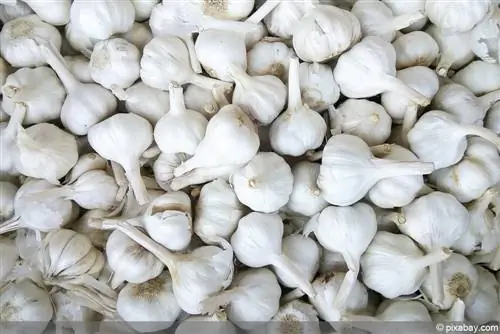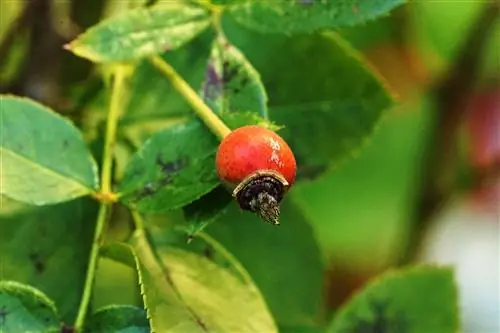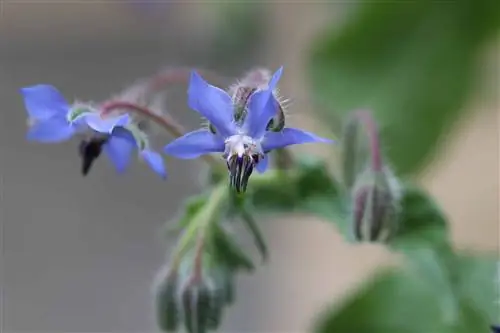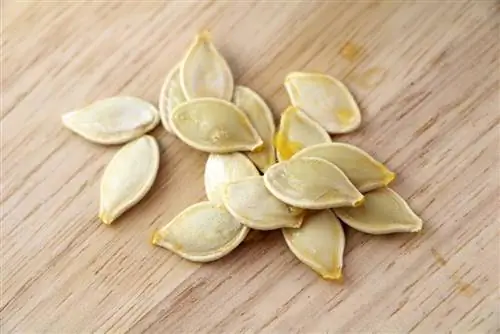- Author admin [email protected].
- Public 2023-12-17 03:39.
- Last modified 2025-06-01 06:48.
Having your own herb bed enriches the garden or balcony not only visually, but also practically. Especially when plants like Moroccan olive herb thrive in it. Proper care is essential for cultivation to produce a profitable harvest. But how should the gardener prune Santolina viridis? And what happens after harvesting? Are the spicy stems suitable for drying? The gardener will find answers to these questions as well as four different instructions for propagating olive herb in this guide.
Cutting
Tip 1: Timing
If you have just planted your olive herb, you should give the plant some time to get used to the location. Otherwise it may happen that the perennial plant only produces a crop once. After just two weeks, the herb usually has developed strong roots. The first pruning should still only be done in the second year.
Tip 2: Protect from woodiness
The evergreen Santolina viridis tends to become woody. A rejuvenation cut in spring or autumn counteracts the process. The more woody the shoots, the less deeply the gardener places the scissors.
Tip 3: Technology
Since Santolina viridis sprouts for several years, the cut is carried out as with conventional perennials:
- shorten by half or at most a third
- remove spent stems completely
- shorten growing shoots only slightly (to half or a third)
- never cut into old wood (place the scissors at least 1 cm above it)
- Cut off thick stalks at an angle so that the rainwater can run off
Note:
Since olive herb is very tolerant of cutting, it is ideal for keeping in containers.
Propagate

To propagate Santolina viridis, the gardener has four different methods to choose from:
Tip 4: Propagation by sowing
- Take seeds in late summer after flowering
- let it dry in a warm place
- store in an airtight container until spring
- start sowing in February at the earliest
- Soak seeds in water for 24 hours
- Fill the cultivation pot with nutrient-poor substrate
- Press seeds lightly into the soil
- Transplant seedlings of appropriate size
Note:
Sowing directly outdoors is not recommended as the seeds will most likely fall victim to voracious snails and birds.
Tip 5: Promote germination
- Olive herb is a cold germinator - needs cold stimulus
- Fill plastic bag with sand
- Put in seeds
- Store in a cool place (for example in the refrigerator) for 3 to 4 weeks
Tip 6: Propagation by division
- Dig up the mother plant in spring
- Divide the root with a sharp knife
- replanting
- Planting distance: 30 cm
Tip 7: Propagation by reducing plants
- Works well because drooping shoots
- Draw a gutter next to the plant
- push in a shoot
- cover with soil
- Branch tip looks out of the ground
- fix with a stone
- Cut off new shoots when they are 10 cm long
- plant in another location
Tip 8: Propagation through cuttings
The best time to take cuttings is spring. Since Santolina viridis forms roots relatively slowly, a rooting powder is recommended. The gardener can get this from specialist retailers.
- Mix rooting powder with soil and sand
- fill into small pots
- Take 20 cm long, slightly woody cuttings
- Remove leaves from the lower part of the stem
- put in the pots
- pour on
- Put a clear plastic bag over the pot (preserves the moisture)
- add water when there are no more water droplets visible on the bag
- Prick out after two weeks
- only plant outdoors after the night frosts have subsided
Tip 9: Make your own alternative rooting powder
The rooting powder available commercially is usually synthetic. Chemical additives are therefore not excluded. However, with simple home remedies, the gardener manages to create a comparable alternative.
- collect fresh, tender willow leaves or scrape off willow bark (about 3 cups), chop them into small pieces, pour boiling water over them, let the broth steep and then collect it
- Dip the stem end of the cutting in cinnamon
- Stir 1 tbsp apple cider vinegar in 6 cups of water and dip the cutting in it
- Dip cutting in honey
- Dissolve uncoated aspirin tablet in water and place the cutting in it for some time
- Drill a hole in a potato and insert the cutting into it
- Dissolve 1 tablespoon of aloe vera juice in water, place the cutting in it for about a week
- Pour lukewarm water over 100 g of dry yeast, place the cutting in it
Note:
If you decide against propagating your own and get your plant from the nursery early, you should definitely pay attention to the substrate when purchasing. Most of the time herbs from specialist shops are poured over. Since Santolina viridis does not tolerate waterlogging, this care mistake will become particularly noticeable sooner or later. Moss in the plant pot is a clear sign of poor quality.
Harvesting
Tip 10: Harvest time
Once the plant has gotten used to its location, the gardener can harvest it permanently. Santolina viridis feels most comfortable
- in a full sunny location
- in well-drained soil
- in predominantly sandy, nutrient-poor soils.
- best harvest time is the morning.
Tip 11: Combine harvesting and cutting
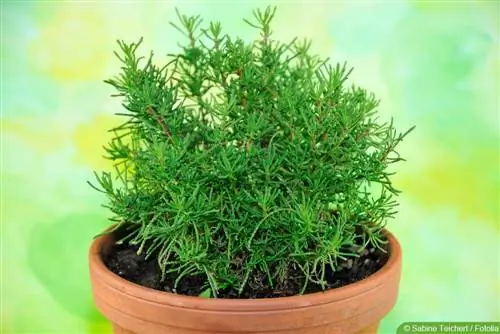
The twigs of olive herb taste best fresh. It is therefore advisable to always cut off the stems in sufficient quantities. Often just one or two stems are enough for culinary use. However, there is nothing wrong with cutting the plant back completely. On the contrary, the gardener encourages bushier growth through branching. For this, cutting back the shoot tips by a few centimeters is sufficient.
Drying
Tip 12: Air drying
The gardener ties the branches together in individual bundles and hangs them upside down. The place should
- shady
- warm
- protected
- and airy
be. Once the moisture has completely escaped, he brushes off the leaves and puts them in an airtight bag.
Tip 13: Drying in the oven
The quicker option is drying in the oven. To do this, the gardener spreads the branches on a baking tray and heats the oven to around 40°C. The door should be left ajar to allow moisture to escape.
Tip 14: Drying in the dehydrator
- Distribute branches on the floors
- select the appropriate program
Note:
The dried branches of the olive herb have a variety of culinary uses. However, the loss of aroma through the drying process cannot be avoided with any of the methods mentioned. In order to keep this as low as possible, drying should be carried out at a low temperature in the gentlest possible way. The gardener should therefore only dry the branches to build up a supply or to preserve the spice in the event of an accidental harvest surplus. Otherwise, fresh consumption is recommended.
Tip 15: Other types of preservation
The taste of the leaves of the olive herb is reminiscent of Mediterranean cuisine. Some people compare the aroma to thyme, others clearly recognize the relationship to olive. Therefore, Santolina viridis can be processed in a similar way to the oil fruit. For example
- pickled in brine
- pickled in oil
- pickled in vinegar
- made into pesto
- frozen



